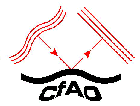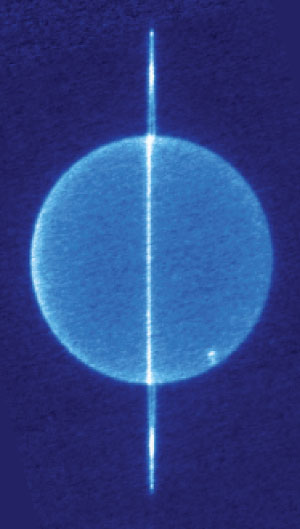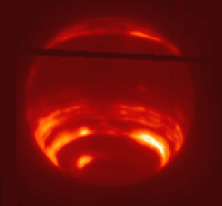|
Adaptive Optics (AO)

|
As members of the (former) Center for Adaptive
Optics (CfAO), we have exploited the adaptive optics systems
at, e.g., the Keck and Gemini
observatories. Turbulence in our atmosphere limits the seeing of telecopes
to approximately 1 arcsecond, while the diffraction limit of a telescope
is approximately equal to the ratio of the wavelength and the diameter
of the mirror. Adaptive
Optics page link
|
|

|
URANUS: ATMOSPHERE AND RINGS: Our group has been observing Uranus with AO on the W.M. Keck II telescope since June 2000.
The image on the left is one of our most recent AO image, taken at a wavelength of ~2 micro-meters. Click the thumbnail for more details on our first ground-based detection of the faint inner rings around that planet, and more recent,
more stunning, images, and references.
|

|
NEPTUNE: ATMOSPHERE, MOONS AND RINGS: AO image of Neptune at a wavelength
of 1.6 micrometer and angular resolution of approximately 0.05''. The
planet is visible in reflected sunlight.
The bright regions are particulate material at high altitudes; the top
of the bright `storms' is located near Neptune's tropopause. The ring arcs have been detected in a different set of images, shown under the thumnail.
Click on he thumbnail for more information, references, and more recent images.
|
|

|
IO: Keck infrared images of Io using speckle and/or
Adaptive Optics techniques provide images as sharp as the best global IR images
obtained with the Galileo spacecraft (NIMS) in orbit about Jupiter. The image
on the left was obtained on 19 Feb. 2001 at a wavelength of 2.2 micron.
Io is seen in reflected sunlight, while thermal emission from volcanic
hot (~1000 K) spots is clearly recognized.
Click on the thumbnail for more Io research, more recent images and movies from our group.
|
|
|
TITAN: We have observed Titan regularly with speckle
techniques and the Adaptive Optics system on the Keck telescope.
Click on he thumbnail for more information, references, and recent images of Titan's
atmosphere and surface.
|
|
|
JUPITER'S RINGS: We have observed the Jovian ring in 1997 and in 2002-2003 with the Keck
telescope at a wavelength of 2.3 micrometer, while the rings were edge-on.
Click on he thumbnail for more information and references.
|
|
|
SATURN'S RINGS: Saturn's rings were observed in Aug.
1995 during Saturn's ring plane crossing. Images of both the main rings
and the faint extended E and G rings were obtained. The bright segment
within the E ring is the G ring.
Click on he thumbnail for more information, references, and images
|
|
|
IMPACT OF COMET SHOEMAKER-LEVY 9 WITH JUPITER: The impacts of comet Shoemaker-Levy
9 with Jupiter in July 1994 were observed world-wide. We used the, at
time recently commissioned, Keck telescope to record some of the impacts.
This is a movie of the impact of fragment R with Jupiter.
Click on he thumbnail for more information, references, and images/movies.
|

